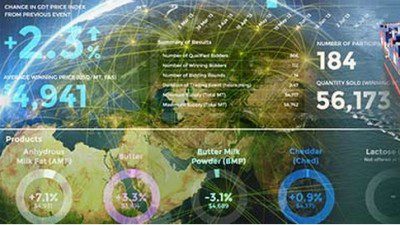Dairy product prices rose 3.8% in the latest Global Dairy Trade auction, the first time this year the auction has posted consecutive positive results.
At the last auction on April 5, dairy product prices rose by 2.1%. Whole milk powder rose 7.5% at today’s auction, while Rennet Casein also rose 7.5%.
Lactose posted a rise of 8% and skimmed milk powder (SMP) was up by 0.3%.
Earlier this week, New Zealand bank ASB suggested that the auction could post a rise and hinted that whole milk powder (WMP) could be up between 1-3%.
Key Results
- AMF index up 1.6%, average price US$3,240/MT
- Butter index up 2.0%%, average price US$2,746/MT
- BMP index up 2.4%, average price US$1,460/MT
- Ched index down 3.9%, average price US$2,636/MT
- LAC index up 8.0%, average price US$708/MT
- RenCas index 7.5%, average price US$4,732/MT
- SMP index up 0.3%, average price US$1,727/MT
- WMP index up 7.5%, average price US$2,156/MT
World dairy prices to remain under pressure until 2017 – Rabobank
Earlier this month, Rabobank announced that it expects global dairy markets are to remain weak throughout 2016 but that the outlook remains positive as consumption continues to rise.
In its quarterly dairy report, it sais that global dairy commodity US Dollar prices have continued to stumble along a market floor largely determined by the level of EU intervention support.
Milk production has continued to slow in the EU and New Zealand as prices remain low.
However, Kevin Bellamy, Rabobank’s Global Dairy Strategist, has said that looking forward, the news is by no means all bad for the dairy industry.
With the exception of Brazil – gripped by the worst recession in a generation – Rabobank sees dairy consumption continuing to grow in Asia, as well as in the US and EU.
The report goes on to say that throughout 2016, slowing production growth will be matched by slow, but steady consumption growth in most main export regions.
Meanwhile, in Europe, Rabobank anticipates that low farmgate prices will mean production growth will slow as farmers focus more on cost-saving than expansion.


